Is it crazy to fix the air conditioning in a roadster?
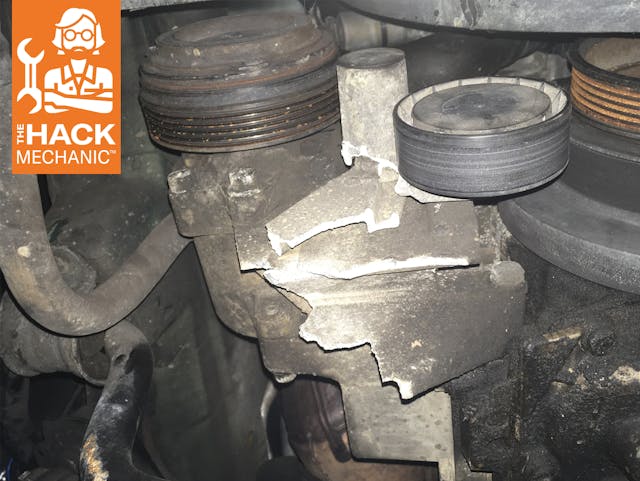
In the forward of my book Just Needs A Recharge, I explain that the title is a joke, as sarcastic as “that’ll buff out”—and equally as false. That is, if a car’s air conditioning system isn’t working, the odds that all it needs is refrigerant are very small.
Refrigerant isn’t something, like oil, that gets consumed through normal operation. If the system is low on refrigerant, it’s because it leaked out somewhere, and the leak must be found and fixed. If you’re lucky, the leak is traced to an easily replaceable o-ring. But, instead, the leak is inside the evaporator assembly under the dash, or if the problem isn’t a leak but a malfunctioning component, repair becomes expensive very quickly. For this reason, I advise people that, if they’re buying a car whose A/C isn’t working and they need it to work as part of their usage profile of the car, they should assume that it’s a $1000 repair. If they’re lucky, it’s less—and if they do the work themselves, it’ll almost definitely be less—but A/C work is rarely quick, easy, or inexpensive.
This was on my mind when I bought back Zelda, the 1999 BMW Z3 2.3 that I’d owned for six years, sold to a friend, and bought back so it wouldn’t be parted out after her son drove it over a median strip. As I wrote (here and here), in addition to bending the lower control arms and denting the wheels, the impact from hitting the curb that surrounded the median strip damaged the car’s air conditioning in three separate ways.
First and most dramatic, the curb strike sheared off the bottom of the bracket holding the compressor to the engine block, taking the belt tensioner with it.

Second, the bottom of the condenser (the part of the A/C system that sits in front of the radiator and dumps the heat that’s being transferred out from the interior of the car) was bent back. When you see something like this, it’s likely that the tubing in the condenser is cracked and the refrigerant has leaked out.

Third, the electric fan assembly on the front of the condenser was also damaged by the curb strike. The fan motor and blades appeared to have been spared, but the bottom of the plastic fan housing was shattered, as was the connector into which the three-pronged plug goes.
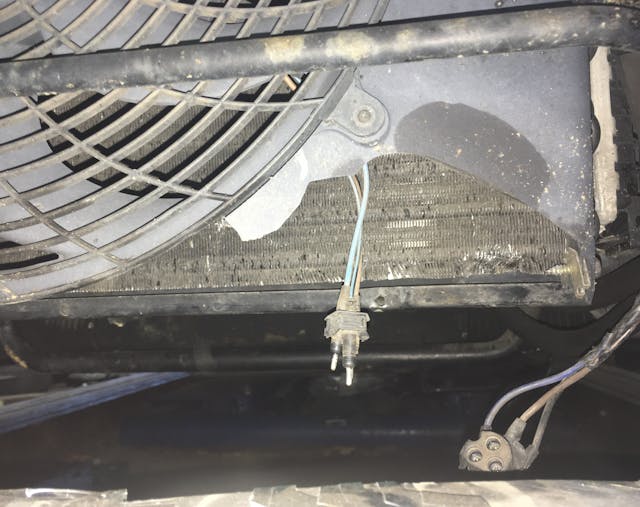
Now, I’d already fixed the primary impact damage from the curb strike, replacing the bent lower control arms and wheels. I’d also, in a matter unrelated to the accident, pulled the transmission and replaced the clutch (the throwout bearing had come apart, making shifting sound like a chainsaw destroying a lathe, or vice versa). Those two repairs made the car drivable, but it is still winter, I live in New England, the car didn’t need to be relied upon as a daily driver, and it could happily sit in the garage until spring. The question was: Should I keep going and fix the air conditioning?
Wikipedia says that the term roadster “originated in the United States, where it was used in the 19th century to describe a horse suitable for travelling” (my wife says, “What, as opposed to a ‘plowster?’”). And, although a section of American hot rod culture traces back to the ubiquitous Model T roadster, for many of us “roadster” conjures up something quintessentially European—maybe an MG TD or a vintage Alfa—and driving with goggles on (or at least sunglasses) and scarf flying, the essence of freedom. Certainly, the appeal of any roadster, vintage or modern, is using it as it is intended—top down, wind in the hair. In that vein, I’ve described Zelda as “rolling Xanax” because of the whole-body relaxation response one gets from dropping a convertible’s top. When I owned my 1982 Porsche 911SC, even though it was a Targa, not a full cabriolet, I kept it in the garage with the top off, only driving it when the sun was out. So, if you own a garaged roadster, why would you ever want to put the top up, much less turn the air conditioning on, much less go to the time, effort, and expense to fix it if it’s broken?
And thus, we get into the term I used at the beginning this article: “usage profile.”
Most vintage roadsters don’t have A/C, so for those, it’s a moot point. And, prior to the ’80s, even if yours did have A/C, in European cars the performance was usually poor. And combined with the less-than-perfect sealing of the top and related rubber gaskets, top up and A/C on would rarely be a go-to move. But the newer the car is, the better the combination of top-sealing and A/C performance.
Anyone who’s ever actually owned a convertible knows that the stress-busting-top-down-wind-in-the-hair-rolling-Xanax-living-the-dream thing is every bit as good as it looks … until it’s 90 degrees out and you’re in direct sun, at which point you fry like an egg. So if you’re actually using the car as a daily driver, commuting to work in it, maybe running errands at lunch, you can easily find yourself pulling over, raising the top, and being glad that you have the same creature comfort of air conditioning that you’ve had in every other car you’ve owned since MTV first played that Buggles video.

And, of course, there’s rain. As much as you might think you’ll leave the top stowed and only pull the car out in the sun, weather can change quickly. Plus, if it does rain, convertibles are more likely to leak, the double-whammy of heat and humidity can fog the windshield quickly, and the best way to clear it is defrost with the A/C on.
After my friend Kim’s son crashed Zelda into the median strip, I bought the Z3 back from her for $500. My own “assume that it’ll cost a thousand bucks to fix a broken A/C system” advice—and seeing the three-part damage with my own eyes—was part of the low buy-back. While I was resurrecting the car, however, the A/C was a minor concern, fourth behind the bent trailing arms and wheels, the splintered front air dam, and the screeching throwout bearing. Fixing the primary curb strike damage and making the car drivable had cost me about $450 (the front air dam still needs to be replaced). The clutch set me back about an additional $350. So in total, I had only about $1300—and a lot of hours—in the car. Thus, on paper, I certainly had headroom to deal with the A/C.
Now, I’m not really one to dwell on being “underwater” in cars, but I do like to think about what makes sense in terms of cost versus how I will actually use the car. I work from home, so even COVID-19 notwithstanding, the Z3 will never be a commuting daily driver (and, since I reinsured it with Hagerty, it really can’t be one anyway). I’ve gone to insane lengths to revive or retrofit A/C into my vintage BMWs, but these are cars I take on 2000-mile round-trip drives to events; that is unlikely to ever happen with the Z3. If, post-crash, someone had taken the Z3 to a repair shop to replace the shattered compressor bracket, bent condenser, and broken fan assembly, that alone might have been enough for an insurance company to total the car. Even doing the work myself, it wouldn’t be inexpensive. Although the Z3 shares many parts with the E36 3 Series sedan, the condenser and fan assembly appear to be Z3-specific parts with list prices of nearly $600 each.
As I thought about it, I realized the decision tree was simple: If the A/C system still had refrigerant in it, that meant the condenser was bent but not punctured, and thus reviving the system would be much easier. If, on the other hand, the median strike had ruptured the condenser, it rapidly became a bigger job—the system would’ve been sitting open for months and thus would need to be flushed to eliminate the possibility of contamination, and the receiver-drier would need to be replaced, as it does whenever an A/C system is left open to moisture.
Fortunately, using a set of manifold gauges, it’s easy to tell if an A/C system still contains refrigerant—just hook the gauge set-up to the A/C service ports. I was thrilled to see the gauges reading about 40 pounds of resting pressure. That sounds low, but it was probably only about 40 degrees in the garage, and as the temperature goes down, so do the pressure readings.
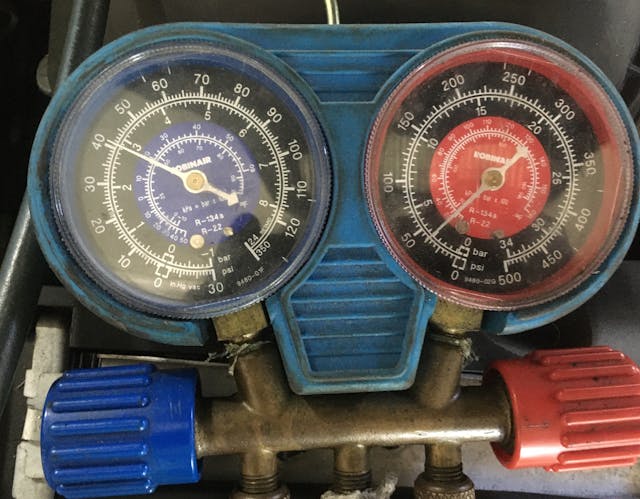
Next, because the keyed electrical connector on the fan had shattered along with the housing, I carefully plugged the individual pins where they were supposed to go and turned on the A/C switch. I found that the fan still spun, although it rubbed against the housing unless I pulled the plastic slightly outward.

I realized as I looked at the housing more carefully, however, that the bottom of the fan housing is supposed to be secured by a bracket at the bottom of the condenser, and with the latter having been pushed back from the impact, even if I bought a new or used fan it wouldn’t bolt up to the bottom of the condenser anymore. So, it seemed like I should either replace both the condenser and fan or replace neither of them. Since the condenser didn’t appear to be punctured and the fan still appeared to turn, the advantage naturally went to “neither.” For now, I can simply use a piece of strapping to secure the bottom of the shattered fan housing to the bent-back bracket, pushing it out slightly, and stop it from rubbing against the fan.
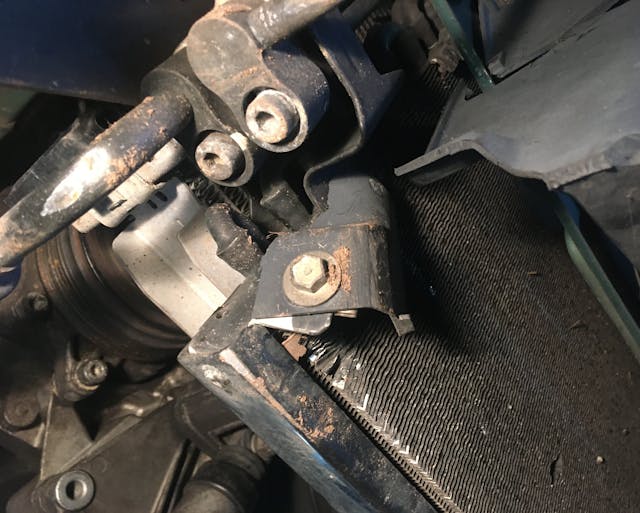
That left the compressor bracket. Fortunately, since you’d only need to replace it if the car hit a curb like Zelda did, and since the part is shared by other six-cylinder E36 3 Series BMWs, it’s ubiquitous on eBay. For $31 shipped, I found not only the bracket but the sub-bracket, tensioner, and idler pulley that also had been carried away by the curb strike.
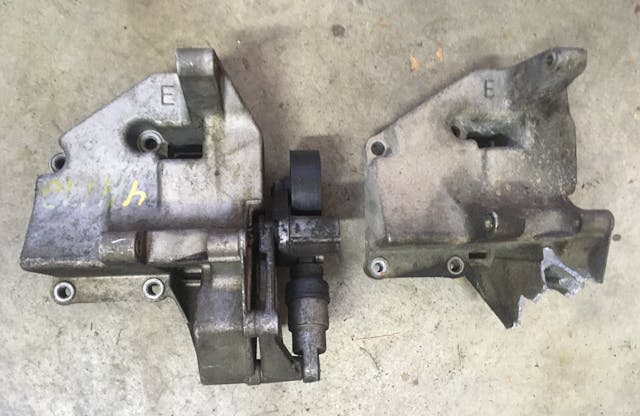
It was a bit challenging to replace the bracket without unbolting the refrigerant lines from the compressor, but I managed to get the compressor off the broken bracket, get the bracket out, and get the replacement bracket in. The next time I put in a parts order to one of my commonly used vendors, I’ll add in the compressor belt.
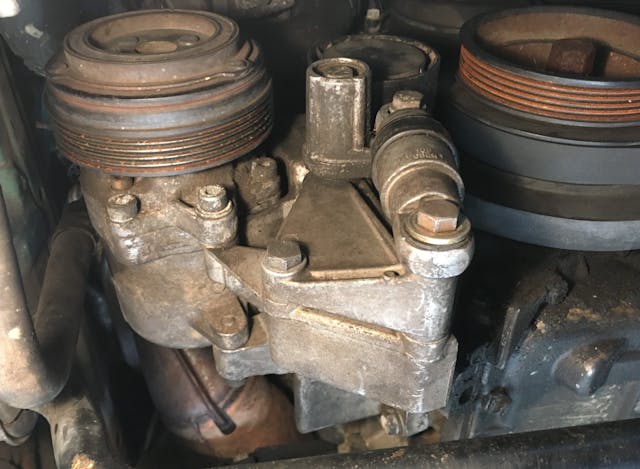
And, with that, my hack air conditioning revival is complete. When the weather warms up, I’ll see how well the A/C system performs. If it’s weak, it probably just needs a recharge …
***
Rob Siegel has been writing a column (The Hack Mechanic™) for BMW CCA Roundel magazine for 34 years and is the author of seven automotive books. His new book, The Lotus Chronicles: One man’s sordid tale of passion and madness resurrecting a 40-year-dead Lotus Europa Twin Cam Special, is now available on Amazon (as are his other books), or you can order personally-inscribed copies from Rob’s website, robsiegel.com.

